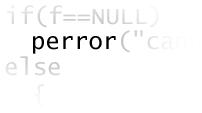
 |
Why are you reading this? Expect some funny stories about me? Private stuff I wouldn't tell my best friends but post on my "homepage"? How I became an AOL customer and how happy I am with it? What?
So, what's all this about? Well, you can look at no photo of me and you can not read private stories about me.
But at least, if you're interested, you can read something about some of the larger computer-related projects I've done so far.
Shawn is an open source simulator for sensor networks which I (co-) develop.
DISCNET
is a commercial application used to generate "good"
resp. mathematically optimized solutions for telecommunication
network planning problems.
Basically, it works like this:
You stuff your company's abilities, cost calculation model,
set of obtainable capacities and links, and estimated traffic
requirements into it, then it gives you a possible survivable
mobile-phone backbone network configuration thats costs
significally less than what you expected, and then you build
something entirely different. Cool, huh?
I've been
employed until 2003 by Atesio
GmbH to work on it.
Participated as student programmer in a project writing a GUI for
DISCNET at the
Konrad-Zuse-Zentrum für Informationstechnik Berlin.
The GUI was presented at the german
CeBIT 2001 exhibition. (That's not true.
The application was presented, and the GUI was used for that.)
Somehow I must've managed to look like someone who know's what he's talking about,
as this project was the reason for my current employment at
Atesio GmbH.
Re-Volt is a commercial racing car game
I like very much.
I wanted to extend the possibilites to create custom race tracks for
this, so I first decoded the game's data files (which was quite interesting -
I was surprised that I managed to understand those binary files), and then
wrote a handful of applications for it.
All of it was released under the
GNU GPL,
look at it on
my download page.
This is a tool I wrote for the
universitary network
where I worked as sysadmin.
It's purpose is to distribute incoming telnet (resp. ssh) sessions to
"free" hosts, i.e. hosts on which currently only a few users are working.
Since it is accessible from the outside, I had to spent a good amount of work
to make it secure. So it is a real low-level program that watches every single
system call it does for errors, and does no operations on string buffers
without keeping an eye on buffer overruns.
This one is a tool one could use to create additional boards for the board game
"RoboRally".
It is a command line tool (tested under Windows, Linux and AIX)
that reads a textual description of a board and creates
an image (1240x1240 pixels, 24 bit colors) that can be printed out.
Unfortunately Wizards Of The Coast
insisted on their copyright, and I am not
permitted to distribute this program.
This was my very first application written in C/C++. It was an attempt to write a
computer port of the board game "Die Siedler von Catan".
It was running under Linux, using SVGAlib for the graphics.
It progressed to a fairly playable stage (including computer opponents that
were able to win the game...). It was abandoned when I learned enough C++ to
see that the whole code design was waste, and I would have to rewrite it
from scratch.
This was a program I wrote for a company that delivered frozen food.
It was written in Pascal for MS-DOS, and was actually still in use when
I left the company. I don't know how long they used it afterwards. (But they
don't use it anymore - it's the mother of all non-y2k-compliant applications...)
It's purpose was to organize the driver's tours, print out bills and tour
descriptions, and to manage the customer's data.
A multi-player online game.
A friend of mine developed a mailbox system for the C64, and I decided to
write a game for it. It was a game where mailbox users controlled armies and
could fight against other players, as well as explore the world and find
ancient artefacts which gave special abilities.
This program was written in AmigaBasic, and we eventually managed it to
port it to the C64, but basically it was just too large for it. (The whole
mailbox system had to be shut down to make the game load, and that took
quite a long time - more than the average mailbox user was willing to wait)
My very first contact with computers happened at age 9, when my father
decided that the son should know something about programming.
We wrote a program in Fortran that printed out calendar sheets with
birthday remarks. That had two huge benefits: For quite some time I
never had to think about birthday presents - everyone got a 10-year wall
calendar from me, and I learned the first few things about computers.